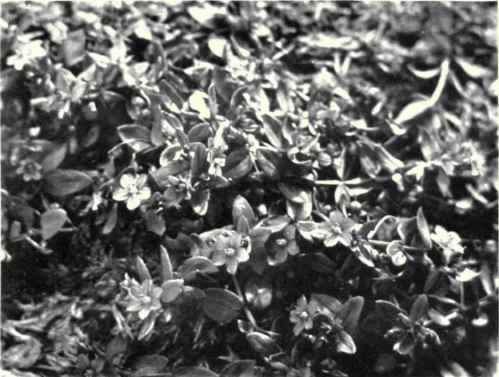Scarlet Pimpernel (Anagallis Arvensis, L.)
Description
This section is from the book "British Wild Flowers - In Their Natural Haunts Vol2-4", by A. R. Horwood. Also available from Amazon: A British Wild Flowers In Their Natural Haunts.
Scarlet Pimpernel (Anagallis Arvensis, L.)
This pretty trailing cornfield weed is apparently quite a modern plant in this country, not having been found in ancient deposits. At the present day it is found in Europe and N. Africa, Siberia, West Asia, as far east as the Himalayas in the North Temperate Zone. It is an introduction in North America. The Scarlet Pimpernel is found in every part of Great Britain except Peebles, Selkirk, Ross, and the Shetland Islands. It is thus common from Ross and Banff southwards. Watson regards it as a colonist in Scotland.
The Scarlet Pimpernel is a typical cornfield plant, growing in open, loamy, clayey fields, rarely lingering long in fields that have run to fallow. It is similarly found in all places that are connected with farming operations, and in the garden, being unable to compete with grass in a meadow, and on the sea coast it is found upon shingle and sand.
This plant has the habit of Wood Loosestrife, which has in fact been called Yellow Pimpernel. The stem is erect or lying on the ground, branched, square, smooth and twisted, with water furrows between the leaves. The leaves are opposite, stalkless, three-nerved, egg-shaped, narrowly elliptical, or heart-shaped, smooth, and with brown dots below.
The flowers are usually scarlet and solitary. They are borne in the axils on long, slender, turned-back flower-stalks. The calyx has a membranous margin and is triangular. The petals are purplish at the base, and the edges are notched and hairy. The corolla is wheel-shaped. The capsule, a pyxis, is shining, 5-nerved, opening transversely, and containing many brown, angular seeds.
Scarlet Pimpernel is usually about 6 in. in height. The flowers bloom between June and September. It is an annual, propagated by seeds.
The flower, which contains no honey, is homogamous (the stamens and pistil maturing simultaneously), so that the flower is usually self pollinated, as it is only expanded from 9 a.m. till 3 p.m., and few insects visit it. If insects visit it, it is both self- and cross-pollinated. The petals unite in a fleshy ring at the base and then spread out vertically 10 - 12 mm. The stamens are projected above the style, which is between them, and is bent down, and an insect settling on the lower parts towards the anthers, first touches the stigma, the anthers being covered with pollen. The stigma may also be self-pollinated. When the flower closes the stigma is drawn back and touches the 3 inferior stamens, which cause it to be self-pollinated, unless insects have visited the flower beforehand, and have removed its pollen, and transferred it, or fresh pollen, to the stigma. The petals soon drop, and as they fall touch the stigma with pollen.

Photo. G. B. Dixon - Scarlet Pimpernel (Anagallis arvensis, L.)
The Scarlet Pimpernel is visited by a Hymenopterous insect, Halictus morio.
The capsule is a many-seeded fruit, and splits up transversely by a circular fissure round the middle when ripe, and the seeds fall out around the parent plant.
The Scarlet Pimpernel is essentially a sand plant growing on sand soil, usually where it is brought into use by cultivation.
The Lepidoptera, Papilio machaon (the Swallow-tail Butterfly), Zygaena purpuralis, and Angle Shades, Phlogophora meticulosa, are the only ones that are found on the plant.
The name Anagallis, Dioscorides, is of doubtful origin. The second Latin name refers to its preference for arable land. Pimpernel is from the Latin bipinnella, applied in the sixteenth century to plants with bipinnate leaves.
There are many names for this plant, as Bird's Eye, Bird's-tongue, Shepherd's Clock, Female Pimpernel (the var. caerulea), John-go-to-bed-at-noon, Male Pimpernel, Merecrop, Orange Lily Pernel, Pimpernel, Poor Man's Weather-glass, Shepherd's Calendar, Shepherd's Delight, Shepherd's Glass, Shepherd's Sundial, Shepherd's Warning, Shepherd's Watch, Sunflower, Tom Pimpernowl, Waywort, Winco-pipe, Wink-a-peep, Weather-glass.
The last name but one is given "from the habit the flower possesses of closing and winking in damp and opening or peeping again in fine weather, and the same reason answers for Shepherd's Clock, etc, and John-go-to-bed-at-noon".
"Boys that mark them shut so soon, Call John that goes to bed at noon." - Clare.
This common wild flower was said by the credulous to counteract the evil designs of malevolent beings. The Scarlet Pimpernel was once used as a cure for hydrophobia. The taste of the plant is acrid, and it has been reported to have killed birds feeding upon it. The name Anagallis has been derived from the Greek anagelao, laugh, because it was used for liver complaints and removed low spirits. One writer says the flower opens at eight minutes past seven and closes at three minutes past two.
Essential Specific Characters: 205. Anagallis arvensis, L. - Stem prostrate or ascending, leaves ovate, dotted beneath, sessile, flowers scarlet, axillary, solitary, petals crenate, filaments free.
Continue to:


